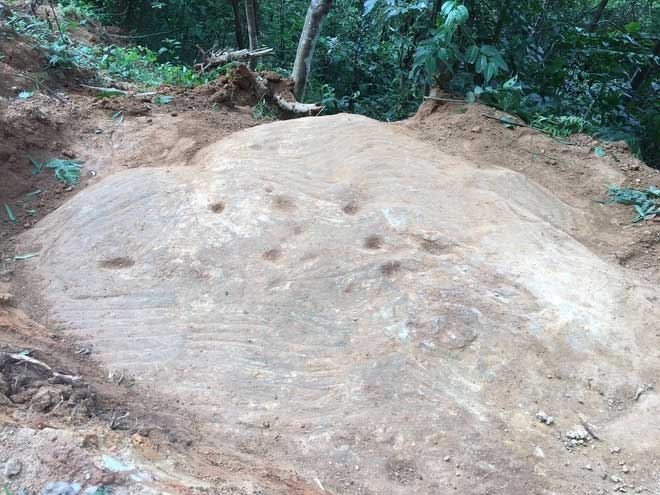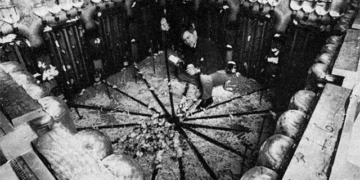Mr. Hoàng Tiến Long, Director of the Yên Bái Provincial Museum, stated that after the discovery of ancient carved stones in Háng Chua Say village (Chế Cu Nha commune, Mù Cang Chải district), museum staff visited the site to assess the value of these ancient stone blocks.
The ancient stone blocks are located within a protected forest area, consisting of several large sandstone blocks (ranging from 1m3 to 20m3) scattered approximately 7-80 meters apart; among them is a carved stone block measuring over 2 meters in length and about 2 meters in width.

Ancient stone block carved with terraced fields in Mù Cang Chải.
This stone block has a slightly convex surface, covered with various carvings: concave circles (7 designs), a concave diamond shape (1 design), a large concentric convex circle (1 design), geometric shapes, and terraced field patterns adorning the edges of the stone, creating a unique and remarkable artwork.
Mr. Lù A Trư, a local official and resident, mentioned that about 20 meters east of this carved stone block lies a large stone approximately 20m3 in size (locally referred to as “father stone”). This is a stone where the Hmong people often come to worship the “stone god” for health. The carved stone is referred to as “mother stone” by the local Hmong community.
Upon preliminary observation, the carvings are quite detailed and skillfully follow the contours of the stone’s surface, resembling terraced fields, which is the main theme of this stone block, similar to those discovered in Lao Chải commune (Mù Cang Chải district) in 2015, 2020, and 2021.
A notable difference in the ancient carved stone at Chế Cu Nha commune is the presence of a convex concentric circle, resembling a drum surface, and a concave diamond shape. This design contrasts with the 14 previously discovered ancient stone blocks in Lao Chải commune.
According to experts from the Yên Bái Provincial Museum, from an ethnological perspective, these may be carvings by the indigenous Hmong people dating back to the 16th-17th centuries. These could represent “designs of terraced fields” or depictions of terraced fields created by those who appreciate the beauty of the structures they have built.
Mr. Lý Kim Khoa, Deputy Director of the Yên Bái Provincial Museum, emphasized that these are not milestone markers, nor are they maps as some have speculated; rather, they could be “design messages of the terraced fields from ancient times or depictions of terraced fields on stone” created by the local people…
From this, it can be inferred that the Hmong people generally prefer living in cool temperate highland climates, relying on agriculture, hunting, gathering, and migration; they are known to be intelligent, creative, and capable of producing all their own tools for farming and hunting, as well as their cultural expressions.
By comparing the carvings, it is evident that the designs closely resemble the terraced fields currently cultivated by this ethnic group, gradually expanding and harmonizing with nature to create beautiful landscapes.
Understanding this research perspective is crucial for interpreting these messages, and there is a strong need for scientists to continue researching and decoding the dating and ethnological aspects of the ancient carved stone site in Mù Cang Chải.
The recent discovery of the ancient carved stone site in Chế Cu Nha and Lao Chải communes has opened up research potential, allowing for a comprehensive survey of ancient carved stones in Mù Cang Chải district… This also provides a scientific basis for planners and developers in exploring tourism linked to terraced fields and the Mù Cang Chải biological conservation area.


















































